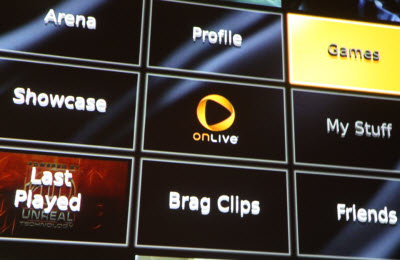
The service, which is in the midst of a closed beta now, worked without a glitch. That’s a big deal, since skeptics have said that what OnLive is trying to do is impossible. But using a cable modem speed connection, Perlman showed that he could play high-speed shooting games across the network, with little or no game processing happening on the client screen.
[aditude-amp id="flyingcarpet" targeting='{"env":"staging","page_type":"article","post_id":161789,"post_type":"story","post_chan":"none","tags":null,"ai":false,"category":"none","all_categories":"business,games,","session":"D"}']“Consumers are buying the game experience, not the console,” Perlman said.
AI Weekly
The must-read newsletter for AI and Big Data industry written by Khari Johnson, Kyle Wiggers, and Seth Colaner.
Included with VentureBeat Insider and VentureBeat VIP memberships.
OnLive created the service over eight years by coming up with a compression technology that enables it to send game content across a network in near real-time, allowing for back-and-forth game play between a player’s screen and a server in the blink of an eye. The delay, or latency, is measured in micro seconds. For standard definition games, Perlman said he needs a 1 megabit per second connection. For high-definition games, the service needs a 5-megabit per second connection. About 26 percent of broadband users have faster than 5-megabit connections, and 71 percent have 2 megabit per second connections, he said.
Perlman said the service was designed for instant gratification and thus fits with the “now era” that consumers have embraced. Perlman noted that surveys show that real-time traffic on sites such as Twitter now accounts for more than 26 percent of all Internet traffic, up from 12 percent a year ago.
Mike McGarvey, chief operating officer, joined Perlman in showing off both Unreal Tournament and Burnout Paradise games, live on the service. It worked without a glitch. The OnLive interface showed live videos of games being played as McGarvey scrolled through menus, deciding what game to play. Perlman showed how you can record a game and post it as a “brag clip” that you can show to your friends, who can watch a recorded video of your own game.
While playing the game in Las Vegas, Perlman said he was connected to a server in the San Francisco Bay Area. The company expects it can cover the country with five data centers and update the servers in them every six months or so.
Perlman’s team also showed that iPhone users could play a high-end game such as Crysis on the service, live in real time. Game publishers should welcome this kind of digital distribution, rather than fear it. The music industry failed to do so and lost its business to pirates. Video and movie companies are also moving too slowly and so the verdict is out as to whether they will head off broadband pirates.
“The games market is ripe for OnLive,” Perlman said. “If we don’t create one, believe me, someone else will. Let’s use this wonderful Internet we have to mitigate piracy.”
[aditude-amp id="medium1" targeting='{"env":"staging","page_type":"article","post_id":161789,"post_type":"story","post_chan":"none","tags":null,"ai":false,"category":"none","all_categories":"business,games,","session":"D"}']
VentureBeat's mission is to be a digital town square for technical decision-makers to gain knowledge about transformative enterprise technology and transact. Learn More
